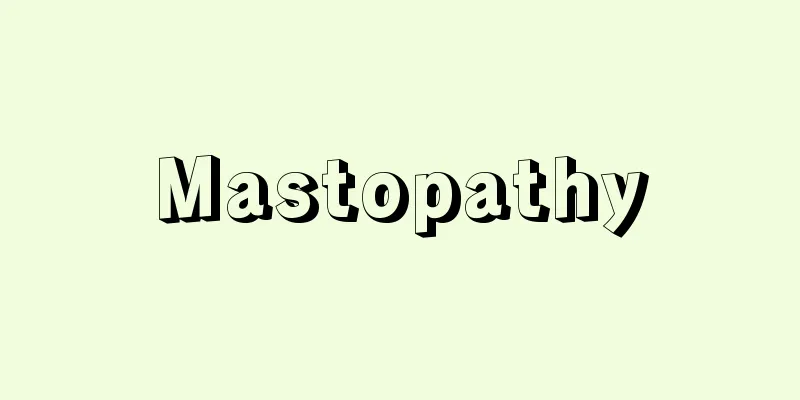Mastopathy

|
What kind of disease is it? ●Main symptoms and course Mastopathy is a disease in which one or several lumps appear or disappear in one or both breasts during the high temperature phase of the menstrual cycle, and from ovulation to menstruation. These are fluid-filled cysts (lumps) that accumulate in the gaps of the mammary glands and are elastic to the touch, but can also be hard. The lumps vary in size and shape, and some have an unclear border with the surrounding area. They are accompanied by pain, and the pain becomes stronger before menstruation and subsides when menstruation begins. In addition, an abnormal secretion (watery, milky, yellowish-brown, bloody, etc.) may come out of the nipple. No special treatment is necessary unless the pain is so severe that it interferes with your daily life. Although fibrocystic mastopathy does not lead to breast cancer, the symptoms can be similar to those of breast cancer and it can be difficult to distinguish between them. If you experience any symptoms that concern you, it is important to get tested and receive an accurate diagnosis. Examinations are performed by palpation, echo (ultrasound) examination, mammography (specialized X-ray photography), etc. If breast cancer cannot be ruled out, detailed examinations using MRI, fine needle aspiration cytology, and needle biopsy are performed. ●Causes of the disease and how symptoms develop It is thought to be caused by an imbalance of female hormones, and it is known that excess estrogen causes changes in breast tissue. ●Characteristics of the disease This disease is most common in people aged 30 to 45. Of all the breast diseases examined in outpatient clinics, mastopathy is the most common. EBM checks on common treatments and care [Treatment and care] Accurately distinguish from breast cancer [Evaluation] ☆☆☆ [Evaluation Points] Clinical studies have shown that 4% of patients over 40 years old who presented with breast-related complaints were found to have breast cancer. If there is any abnormality in the breast, it is important to first determine whether it is breast cancer or not. (1) [Treatment and care] If a cyst is present, drain the accumulated fluid. [Rating] ☆☆ [Evaluation points] Although there are no clinical studies comparing the post-treatment progress between when the fluid is drained from the cysts and when it is not, this method is supported by expert opinion and experience. [Treatment and care] If pain is severe, hormone therapy drugs are used. [Rating] ☆☆☆☆ [Evaluation Points] The effectiveness of hormone therapy drugs in relieving breast pain has been confirmed through reliable clinical studies. (2)(3) [Treatment and care] If the pain is very severe, use analgesics. [Rating] ☆☆ [Evaluation points] There are no clinical studies comparing the progress of using analgesics for fibrocystic breast disease with enduring the pain without using them, but expert opinion and experience support the use of pain suppression in severe cases. [Treatment and care] Limit caffeine and fat intake, and increase carbohydrate intake [Rating] ☆☆ [Points to consider] Recent studies have shown that limiting caffeine intake is ineffective. However, since limiting caffeine intake is harmless and does not require medical expenses, it may be worth a try. Observational studies have shown that limiting fat intake and increasing carbohydrate intake are effective. (4) [Treatment and care] Take iodine [Rating] ☆☆☆ [Evaluation points] Clinical studies have shown that iodine contained in seaweed has minimal effect on the thyroid gland and is effective. (5) [Treatment and care] Monthly self-examination and breast cancer screening at least once a year [Rating] ☆☆☆☆ [Evaluation Points] There are no reliable clinical studies on self-examination, but there are clinical studies that show that people who have been diagnosed with or are suspected of having fibrocystic breast disease can avoid the risk of cancer by performing breast self-examinations. Breast cancer screening is a simple and inexpensive test. Regular screening allows for early detection. In the United States, mammography screening is recommended for people over the age of 50. (6) Checking commonly used drugs with EBM Hormonal therapy drug [Drug name] Bonzol (Danazol) (2) (3) [Rating] ☆☆☆☆ [Evaluation points] The effectiveness of danazol in correcting female hormone balance has been confirmed through reliable clinical studies. Tamoxifen (a selective estrogen receptor modulator) has also been shown to improve pain, but may increase the risk of uterine cancer and thromboembolism. Milk secretion suppressant [drug name] Parlodel (bromocriptine mesylate) (7) [Rating] ☆☆ [Evaluation points] If lactation occurs, medication to suppress lactation is taken. This has been confirmed by reliable clinical studies, but is not recommended due to the many side effects. Overall, it is the most reliable treatment method currently available .<br /> If it does not interfere with your daily life, no treatment is necessary. Even if you are diagnosed with fibrocystic breast disease, unless the pain is so severe that it interferes with your daily life, it is best not to undergo special treatment. Any treatment carries with it the possibility of side effects or complications. If the pain in your breasts is severe, try taking oral medication to relieve it. To relieve breast pain, first try using Bonzol (Danazol), which has the effect of suppressing the secretion of GnRH, a hormone released from the pituitary gland in the brain. The effectiveness of Danazol has been confirmed by reliable clinical studies. If lactation occurs, use a lactation suppressant, Parlodel (bromocriptine mesylate). This drug has been shown to be effective in reliable clinical studies, but it has side effects and is not recommended. If you are diagnosed with or suspected to have fibrocystic mastopathy, you should undergo breast cancer screening. Although fibrocystic mastopathy rarely leads to breast cancer, it can have symptoms similar to those of breast cancer or can occur together with breast cancer, so if you experience any symptoms that concern you, you should undergo screening. In particular, women who have had a long period between menarche and their first pregnancy or between menarche and menopause, women undergoing hormone replacement therapy, and women with family members or relatives who have had breast cancer are advised to undergo regular breast cancer screening in addition to being examined for mammopathy. In Europe and the United States, mammography screening is recommended for women over 50 as it can lead to early detection of breast cancer. In Japan, mammography screening is recommended for women over 40. Iodine intake is effective in treating fibrocystic breast disease. Clinical studies have shown that the iodine contained in seaweed has little effect on the thyroid gland and is effective against fibrocystic breast disease. Iodine is found in large amounts in seaweed, wakame seaweed, kelp, and hijiki seaweed. (1)BROOKE SALZMAN, MD, STEPHENIE FLEEGLE, MD, and AMBER S. TULLY, MD, Thomas Jefferson University Hospital, Philadelphia, Pennsylvania “Common Breast Problems” Am Fam Physician. 2012 Aug 15;86(4):343-349. Source: "EBM: A book that explains correct treatment" Information about the book "EBM: A book that explains correct treatment" |
|
どんな病気でしょうか? ●おもな症状と経過 乳腺症(にゅうせんしょう)は月経周期の高温期、排卵(はいらん)から月経の時期に、乳房の片方、あるいは両方に1個から数個のしこりが触れたり、消えたりする病気です。これは、乳腺のすき間に水がたまったもの(のう胞(ほう))で、触ると弾力性に富んでいますが、硬い場合もあります。しこりの大きさや形はいろいろあり、周囲との境界がはっきりしないものもみられます。痛みを伴い、とくに、月経前には痛みが強くなり、月経が始まると軽くなります。また、乳頭(にゅうとう)から異常な分泌(ぶんぴつ)液(水様、乳汁様(にゅうじゅうよう)、黄褐色(おうかっしょく)、血性など)がでることもあります。 日常生活に支障をきたすほど痛みが強い場合以外は、とくに治療する必要はありません。 乳腺症から乳がんになることはありませんが、乳がんと似ている症状だったり、乳がんとの見分けが難しいこともあるため、気になる症状がみられたら検査を受けて、正確に診断してもらうことが必要です。 検査は触診、またはエコー(超音波)検査やマンモグラフィー(特殊なエックス線撮影)、で行います。乳がんが否定できない場合には、MRIによる精密検査や穿刺(せんし)吸引細胞診、針生検(はりせいけん)を行います。 ●病気の原因や症状がおこってくるしくみ 女性ホルモンのバランスの崩れが原因と考えられていて、エストロゲンが過剰になると、乳腺組織が変化することがわかっています。 ●病気の特徴 30歳~45歳に多くみられる病気です。外来で診察する乳腺の病気のなかで、乳腺症は一番多くみられます。 よく行われている治療とケアをEBMでチェック [治療とケア]乳がんとの区別を確実に行う [評価]☆☆☆ [評価のポイント] 乳房に関する訴えのある、40歳以上の受診者の4パーセントに乳がんがみられたという臨床研究があります。乳房になんらかの異常がある場合は、まず乳がんであるかないかを確かめることが重要です。(1) [治療とケア]のう胞がある場合は、たまっている液を排出する [評価]☆☆ [評価のポイント] のう胞から液を排出した場合としない場合で、治療後の経過を比較した臨床研究は見あたりませんが、専門家の意見や経験から支持されています。 [治療とケア]痛みが強い場合は、ホルモン療法薬を用いる [評価]☆☆☆☆ [評価のポイント] ホルモン療法薬の乳房の痛みをやわらげる効果は、信頼性の高い臨床研究で確認されています。(2)(3) [治療とケア]非常に痛みが強い場合は、鎮痛薬を用いる [評価]☆☆ [評価のポイント] 乳腺症に対して鎮痛薬を使用した場合と、使用せず痛みをがまんした場合の経過を比較した臨床研究は見あたりませんが、痛みの強い場合にそれを抑えることは専門家の意見や経験から支持されています。 [治療とケア]カフェイン・脂肪の摂取を制限する、炭水化物を多く摂取する [評価]☆☆ [評価のポイント] カフェインの制限に関しては、最近の研究では、効果がなかったとするものが優勢です。しかし、カフェイン制限は無害で医療費もかからないため、試してみてもよいでしょう。 脂肪制限と炭水化物を多く摂取することについては観察研究で効果があるとされているようです。(4) [治療とケア]ヨードをとる [評価]☆☆☆ [評価のポイント] 海藻などに含まれるヨードは甲状腺(こうじょうせん)への影響も少なく、有効であったという臨床研究があります。(5) [治療とケア]毎月の自己検診、少なくとも年1回の乳がん検診を行う [評価]☆☆☆☆ [評価のポイント] 自己検診についての信頼性の高い臨床研究はありませんが、乳腺症の診断を受けた人、あるいは疑いのある人が、乳がんの自己検診をすることでがんのリスクを回避できるという臨床研究があります。乳がん検診は、簡便で、費用もあまりかからない検査です。定期的に検査を受けることで早期発見が可能になります。アメリカでは50歳以上で、マンモグラフィーによる検診が推奨されています。(6) よく使われている薬をEBMでチェック ホルモン療法薬 [薬名]ボンゾール(ダナゾール)(2)(3) [評価]☆☆☆☆ [評価のポイント] 女性ホルモンのバランスを是正するダナゾールの効果は信頼性の高い臨床研究で確認されています。 タモキシフェン(選択的エストロゲン受容体調節因子)も痛みを改善することがわかっていますが、子宮体がんや血栓塞栓症(けっせんそくせんしょう)を増加させることがあります。 乳汁分泌抑制薬 [薬名]パーロデル(ブロモクリプチンメシル酸塩)(7) [評価]☆☆ [評価のポイント] 乳汁分泌がある場合には、分泌を抑制する薬を服用します。このことは信頼性の高い臨床研究で確認されていますが、副作用が多いため、推奨されません。 総合的に見て現在もっとも確かな治療法 日常生活で困ることがなければ、治療は不要 乳腺症と診断されても、日常生活に支障をきたすほど痛みが強くなければ、特別な治療はしないほうがよいでしょう。 あらゆる治療には、副作用や合併症が引きおこされる可能性がゼロではないからです。 乳房の痛みが強いときは、内服薬でやわらげる 乳房の痛みをやわらげるときには、まず、脳の下垂体(かすいたい)から放出するホルモンであるGnRHの分泌を抑制する効果があるボンゾール(ダナゾール)を用います。ダナゾールに関しては、信頼性の高い臨床研究でその効果が確認されています。 乳汁分泌がみられるときには、乳汁分泌抑制薬を 乳汁分泌があって困るときには、乳汁分泌抑制薬のパーロデル(ブロモクリプチンメシル酸塩)を用います。この薬は信頼性の高い臨床研究で効果が確認されていますが、副作用があり推奨されていません。 乳腺症と診断されたり、疑われたりした場合は、乳がん検診を 乳腺症から乳がんになることはほとんどありませんが、乳がんと似ている症状だったり、乳がんを合併していることもあったりするため、気になる症状がみられたら検査を受けることが必要です。 とくに、「初経から最初の妊娠までの期間や初経から閉経までの期間が長い女性」、「ホルモン補充療法を行っている女性」、「家族や親類に乳がん患者がいる女性」などは、乳腺症の診察とともに、乳がん検診を定期的に受けるよう勧められます。欧米では50歳以上の女性は、マンモグラフィーによる検診が乳がんの早期発見につながるため推奨されています。わが国では40歳以上の女性に対してマンモグラフィーによる検診が勧められています。 ヨード摂取は乳腺症治療に有効 海藻などに含まれるヨードは甲状腺への影響も少なく、乳腺症に対して有効であったという臨床研究があります。ヨードはのりやわかめ、昆布(こんぶ)、ひじきなどに多く含まれています。 (1)BROOKE SALZMAN, MD, STEPHENIE FLEEGLE, MD, and AMBER S. TULLY, MD, Thomas Jefferson University Hospital, Philadelphia, Pennsylvania “Common Breast Problems” Am Fam Physician. 2012 Aug 15;86(4):343-349. 出典 法研「EBM 正しい治療がわかる本」EBM 正しい治療がわかる本について 情報 |
Recommend
Clubiona
…A general term for spiders belonging to the genu...
Charlottetown Conference - Charlottetown Conference
The Conference for the Formation of Canadian Confe...
Goldie, G. (English spelling) GoldieG
...a Royal Company that promoted British commerci...
uplift
…The original meaning is shoulder straps. It is a...
Cottrell, FG (English spelling) CottrellFG
...A type of dust collection method in which dust...
Black sea cucumber - Black sea cucumber
A marine animal belonging to the phylum Echinoder...
feet
…equals 1/3 of a yard, which is effectively exact...
Class action
A class action is a type of litigation developed i...
Psychotria serpens (English spelling) Psychotriaserpens
…[Mr. Makoto Fukuoka]. … *Some of the terminology...
Irimizu Cave - Irimizu Cave
This limestone cave lies in the eastern part of F...
Official road - Kando
〘 noun 〙 A road that is constructed and supervised...
hākān (English spelling)
The second half of the 16th century saw some expa...
Muḥammad b.'Abd al‐Wahhāb
1703‐91 A religious leader in the Najd region of t...
fall line
…A topography in which numerous waterfalls, rapid...
Yakata - Yakata
1. A mansion where a person of high rank or social...









